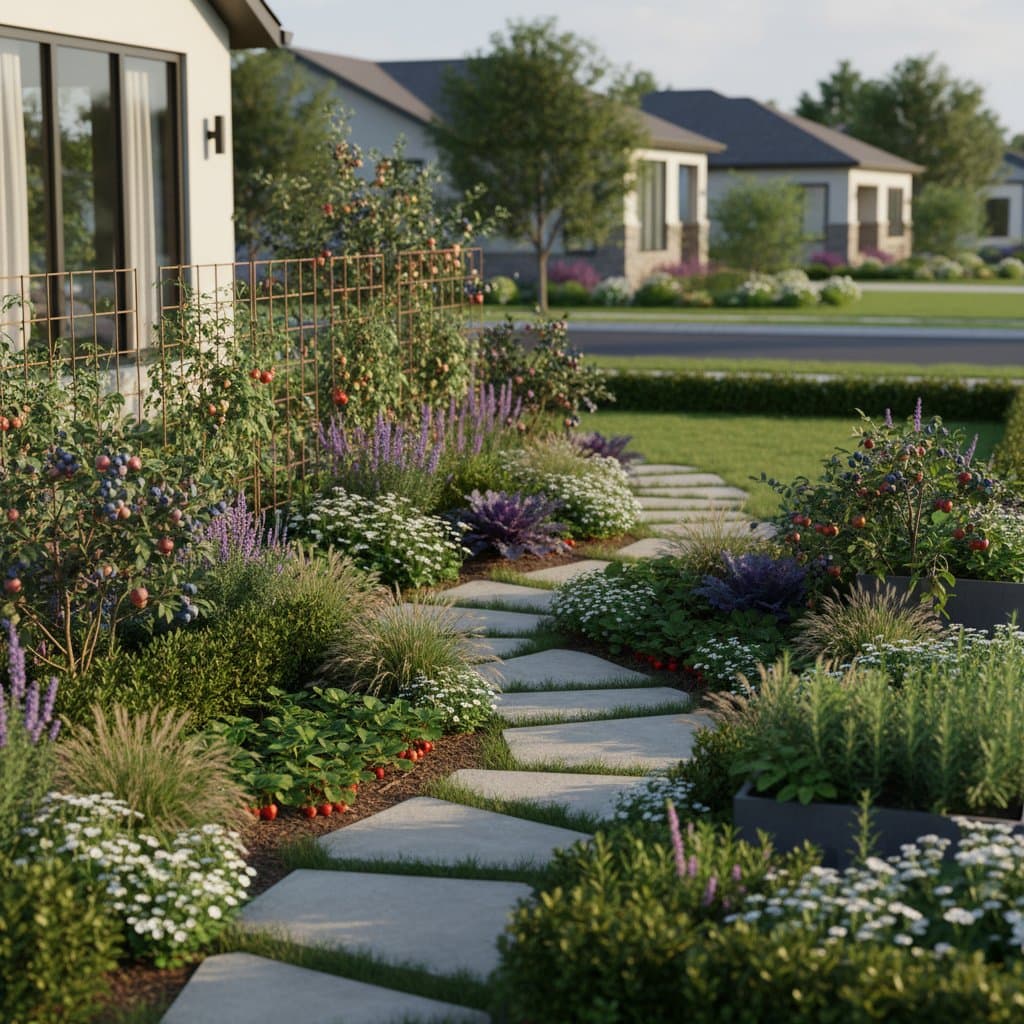- Resource conservation: In dry regions, policies limit water-heavy crops to support local water-saving initiatives.
- Risk reduction: Fruit that falls from trees near walkways creates hazards. Restrictions often apply in common areas.
With this knowledge, homeowners design compliant landscapes that support community priorities.
Strategies for Concealed Edible Gardens
Homeowners use discreet methods to incorporate edibles into ornamental elements. These techniques keep gardens productive without sacrificing curb appeal.
Merging Edibles with Decorative Plants
Choose edibles that offer natural beauty for borders. Rainbow chard delivers colorful leaves that complement annual flowers. Blueberries with lavender tones resemble flowering shrubs. Combine them with evergreens or wildflowers to create a cohesive and attractive display.
Leveraging Containers and Vertical Elements
Place compact vegetables like tomatoes or peppers in patio pots or on balcony rails, out of street view. Use wall-mounted trellises for pole beans or vining grapes to utilize vertical space. These movable setups adjust easily to policy updates or seasonal needs.
Opting for Discreet Edible Varieties
Select compact varieties such as patio peach trees or bush basil that serve as decorative accents. Edible flowers like calendula provide color along pathways. These choices yield harvests without changing the landscape's refined appearance.
Incorporating into Current Landscapes
Improve existing beds by replacing low performers with edibles. Position arugula among ferns or line a walkway with strawberry plants. Achieve balance through uniform spacing and regular pruning to avoid attention.
Building a Hidden Edible Garden: A Step-by-Step Guide
Approach garden development systematically to promote durability and adherence to rules. This process reduces risks and increases productivity.
- Review HOA documents. Identify bans on edibles and permissions for ornamental plants. Note procedures for requesting changes.
- Assess site conditions. Identify private and public zones. Consider soil quality, sunlight levels, and access routes.
- Create a plan. Blend edibles symmetrically with native or perennial plants. Use graph paper or design software for accuracy.
- Select hardy varieties. Choose species suited to your climate zone, such as drought-resistant herbs or cold-hardy berries.
- Install efficient irrigation. Use subsurface drip lines to water roots directly. This method saves water and hides equipment.
- Maintain consistent care. Perform weekly trimming and apply mulch to keep areas neat. Harvest promptly to prevent seed dispersal.
This approach converts challenges into chances for a vibrant, compliant outdoor space.
Deciding Between DIY and Professional Assistance
Match your method to your skills and project size. Both options provide unique advantages for effective outcomes.
Benefits of a DIY Effort
Individuals with basic gardening knowledge can manage the project personally for customization and cost savings. Reach out to local extension services for advice tailored to your area on blending edibles. Begin with a small trial area to perfect methods before scaling up.
Advantages of Expert Involvement
Complex landscapes benefit from a landscape architect or certified horticulturist. Professionals evaluate microclimates and recommend ideal spots, such as understory fruits under larger trees. Their input prevents expensive mistakes and facilitates smooth HOA approval.
Experts typically charge $50 to $150 per hour. Complete projects range from $1,000 for simple designs to $10,000 for full installations. The initial investment leads to long-term gains in yield and compliance.
Selecting a Reliable Landscape or Tree Expert
Choose professionals carefully to form a productive collaboration. Prioritize those with experience in sustainable designs.
- Check credentials. Look for ISA Certified Arborist certification or ASLA membership to confirm expertise.
- Examine portfolios. Review examples of edible garden integrations in HOA-governed areas.
- Discuss regulations early. Ensure familiarity with HOA approval processes and variance options.
- Plan ongoing maintenance. Cover topics like seasonal fertilization to support plant vitality.
A competent partner helps achieve objectives while handling administrative challenges.
Essential Questions for Launching Your Garden
Address key concerns at the start to proceed with assurance.
- What qualifies as ornamental in the community? Herbs such as rosemary qualify as shrubs when pruned neatly.
- Does pre-approval require submission? Provide drawings that present edibles as decorative features to speed approval.
- How to maintain long-term compliance? Conduct monthly self-checks and document care routines to show responsibility.
- What works for small lots? Stack pots along walls or train fruits in espalier form on fences for space efficiency.
- How to manage wildlife attraction? Use row covers and mixed plantings to discourage pests without damage.
- Does this affect property value? Well-designed gardens attract environmentally aware buyers and may increase offers by 5 to 10 percent.
- How to involve family members? Assign rotating tasks like weeding or harvesting to encourage participation.
These questions guide a successful implementation.
Addressing Typical Hurdles in Edible Gardening
Prepare for common challenges to overcome them efficiently.
- Limited sunlight: Select shade-tolerant options like beets or sorrel for low-light areas.
- Poor soil quality: Improve with organic layers and test pH yearly to optimize nutrients.
- Neighbor concerns: Offer casual demonstrations to highlight the garden's appeal and advantages.
- Pest issues: Release beneficial insects like ladybugs or plant marigolds as natural repellents.
Forward-thinking solutions turn problems into valuable lessons.
Environmental and Community Advantages of Edible Landscapes
Edible gardens offer benefits that reach beyond individual use and promote ecological well-being. They reduce transportation distances for produce, which decreases carbon emissions. Varied plantings attract pollinators like bees and birds, bolstering local biodiversity.
Practices such as collecting rainwater enhance water conservation. Families receive practical lessons on food production, which builds connections through collaborative activities.
Fostering Sustainable Community Spaces
Integrating edibles demonstrates that rules can inspire rather than limit creativity. Homeowners balance beauty and productivity to produce fresh food among ornamental plants.
As more people adopt these practices, communities become greener with resilient, food-secure landscapes. Review your guidelines, sketch compliant plans, and select versatile plants to begin. Your yard can sustain both health and the environment.
